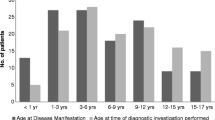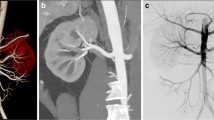Abstract
Historically, the evaluation of renovascular hypertension has been accomplished by US, renal scintigraphy and digital subtraction angiography. Based on its high accuracy reported in adults renal CT angiography (CTA) with pediatric-appropriate low radiation dose techniques has become an important tool in the workup of renovascular hypertension in children. Renal CTA has several advantages over more conventional imaging modalities, including rapid and non-invasive acquisition, high resolution and easy reproducibility. Additionally, in our experience high-quality renal CTA can be performed using low-dose radiation exposures and can be acquired without sedation in most instances. This article illustrates by examples the usefulness of renal CTA for diagnosis of childhood renovascular hypertension and provides an overview of renal CTA findings in the most common childhood renovascular diseases.















Similar content being viewed by others
References
Bayazit AK, Yalcinkaya F, Cakar N et al (2007) Reno-vascular hypertension in childhood: a nationwide survey. Pediatr Nephrol 22:1327–1333
Bartosh SM, Aronson AJ (1999) Childhood hypertension. An update on etiology, diagnosis, and treatment. Pediatr Clin N Am 46:235–252
Dillon MJ (1997) The diagnosis of renovascular disease. Pediatr Nephrol 11:366–372
Stanley JC, Criado E, Upchurch GR Jr et al (2006) Pediatric renovascular hypertension: 132 primary and 30 secondary operations in 97 children. J Vasc Surg 44:1219–1228
Ghabril R (2010) Renovascular hypertension in children. J Med Liban 58:146–148
Tullus K, Brennan E, Hamilton G et al (2008) Renovascular hypertension in children. Lancet 371:1453–1463
Srinivasan A, Krishnamurthy G, Fontalvo-Herazo L et al (2011) Spectrum of renal findings in pediatric fibromuscular dysplasia and neurofibromatosis type 1. Pediatr Radiol 41:308–316
Srinivasan A, Krishnamurthy G, Fontalvo-Herazo L et al (2010) Angioplasty for renal artery stenosis in pediatric patients: an 11-year retrospective experience. J Vasc Interv Radiol 21:1672–1680
McTaggart SJ, Gulati S, Walker RG et al (2000) Evaluation and long-term outcome of pediatric renovascular hypertension. Pediatr Nephrol 14:1022–1029
Tullus K (2011) Renal artery stenosis: is angiography still the gold standard in 2011? Pediatr Nephrol 26:833–837
Vo NJ, Hammelman BD, Racadio JM et al (2006) Anatomic distribution of renal artery stenosis in children: implications for imaging. Pediatr Radiol 36:1032–1036
Miksys N, Gordon CL, Thomas K et al (2010) Estimating effective dose to pediatric patients undergoing interventional radiology procedures using anthropomorphic phantoms and MOSFET dosimeters. AJR Am J Roentgenol 194:1315–1322
Glockner JF, Vrtiska TJ (2007) Renal MR and CT angiography: current concepts. Abdom Imaging 32:407–420
Sabharwal R, Vladica P, Coleman P (2007) Multidetector spiral CT renal angiography in the diagnosis of renal artery fibromuscular dysplasia. Eur J Radiol 61:520–527
Cho E-S, Yu J-S, Ahn J-H et al (2012) CT angiography of the renal arteries: comparison of lower-tube-voltage CTA with moderate-concentration iodinated contrast material and conventional CTA. AJR Am J Roentgenol 199:96–102
Vade A, Agrawal R, Lim-Dunham J et al (2002) Utility of computed tomographic renal angiogram in the management of childhood hypertension. Pediatr Nephrol 17:741–747
Hellinger JC, Pena A, Poon M et al (2010) Pediatric computed tomographic angiography: imaging the cardiovascular system gently. Radiol Clin N Am 48:439–467
Boone JM, Strauss KJ, Cody DD et al (2011) Report of AAPM Task Group 204. Size-specific dose estimates (SSDE) in pediatric and adult body CT examinations. Available via http://www.aapm.org/pubs/reports/rpt_204.pdf. Accessed 15 Oct 2012
Epelman M, Kreiger PA, Servaes S et al (2010) Current imaging of prenatally diagnosed congenital lung lesions. Semin Ultrasound CT MR 31:141–157
Fleischmann D, Kamaya A (2009) Optimal vascular and parenchymal contrast enhancement: the current state of the art. Radiol Clin N Am 47:13–26
Kalva SP, Sahani DV, Hahn PF et al (2006) Using the K-edge to improve contrast conspicuity and to lower radiation dose with a 16-MDCT: a phantom and human study. J Comput Assist Tomogr 30:391–397
Hellinger JC, Medina LS, Epelman M (2010) Pediatric advanced imaging and informatics: state of the art. Semin Ultrasound CT MR 31:171–193
Cody DD (2002) AAPM/RSNA physics tutorial for residents: topics in CT. Image processing in CT. Radiographics 22:1255–1268
Fishman EK, Ney DR, Heath DG et al (2006) Volume rendering versus maximum intensity projection in CT angiography: what works best, when, and why. Radiographics 26:905–922
Slovut DP, Olin JW (2004) Fibromuscular dysplasia. N Engl J Med 350:1862–1871
Das C, Neyaz Z, Thapa P et al (2007) Fibromuscular dysplasia of the renal arteries: a radiological review. Int Urol Nephrol 39:233–238
Fossali E, Signorini E, Intermite RC et al (2000) Renovascular disease and hypertension in children with neurofibromatosis. Pediatr Nephrol 14:806–810
Hamilton SJ, Friedman JM (2000) Insights into the pathogenesis of neurofibromatosis 1 vasculopathy. Clin Genet 58:341–344
Riccardi VM (2000) The vasculopathy of NF1 and histogenesis control genes. Clin Genet 58:345–347
Connolly B, Kelehan P, O’Brien N et al (1994) The echogenic thalamus in hypoxic ischaemic encephalopathy. Pediatr Radiol 24:268–271
Connolly JE, Wilson SE, Lawrence PL et al (2002) Middle aortic syndrome: distal thoracic and abdominal coarctation, a disorder with multiple etiologies. J Am Coll Surg 194:774–781
Delis KT, Gloviczki P (2005) Middle aortic syndrome: from presentation to contemporary open surgical and endovascular treatment. Perspect Vasc Surg Endovasc Ther 17:187–203
Rose C, Wessel A, Pankau R et al (2001) Anomalies of the abdominal aorta in Williams-Beuren syndrome—another cause of arterial hypertension. Eur J Pediatr 160:655–658
Radford DJ, Pohlner PG (2000) The middle aortic syndrome: an important feature of Williams’ syndrome. Cardiol Young 10:597–602
Pober BR, Lacro RV, Rice C et al (1993) Renal findings in 40 individuals with Williams syndrome. Am J Med Genet 46:271–274
Salerno AE, Marsenic O, Meyers KE et al (2010) Vascular involvement in tuberous sclerosis. Pediatr Nephrol 25:1555–1561
Gulati A, Bagga A (2010) Large vessel vasculitis. Pediatr Nephrol 25:1037–1048
Visrutaratna P, Srisuwan T, Sirivanichai C (2009) Pediatric renovascular hypertension in Thailand: CT angiographic findings. Pediatr Radiol 39:1321–1326
Gotway MB, Araoz PA, Macedo TA et al (2005) Imaging findings in Takayasu’s arteritis. AJR Am J Roentgenol 184:1945–1950
Acknowledgments
This work was awarded with Honorable Mention as an educational poster at the Society for Pediatric Radiology 55th Annual Meeting & Postgraduate Course 2012, San Francisco, CA.
We would like to thank Xiaowei (Winnie) Zhu, MS, for her help and contribution to this manuscript.
Conflicts of interest
None.
Disclosure
The authors listed below have indicated they have no relevant financial relationships or potential conflicts of interest related to the material.
Author information
Authors and Affiliations
Corresponding author
Additional information
CME activity This article has been selected as the CME activity for the current month. Please visit the SPR Web site at www.pedrad.org on the Education page and follow the instructions to complete this CME activity.
Rights and permissions
About this article
Cite this article
Kurian, J., Epelman, M., Darge, K. et al. The role of CT angiography in the evaluation of pediatric renovascular hypertension. Pediatr Radiol 43, 490–501 (2013). https://doi.org/10.1007/s00247-012-2567-z
Received:
Revised:
Accepted:
Published:
Issue Date:
DOI: https://doi.org/10.1007/s00247-012-2567-z




